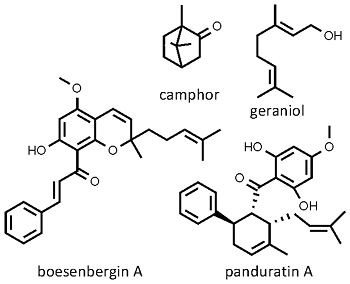 Boesenbergia rotunda
Boesenbergia rotunda
fingerroot • Chinese keys • krachai • suo shi
Back to “Spices: Chinese keys (Boesenbergia rotunda)rh”
Boesenbergia rotunda (L.) Mansf. [= B. pandurata (Roxb.) Schltr.] (Zingiberaceae); vingerwortel (Afrikaans); ao chun jiang, suo shi (Chinese); Chinesischer Ingwer (German); temu kunchi (Malay); kunci (Indonesian); krachai (Thai); bong nga truat, cu ngai, ngai num kho (Vietnamese)
DESCRIPTION Fingerroot comprises the short rhizome with several finger-like roots attached. The roots are orange-brown, yellow on cut surfaces with a highly aromatic, spicy flavour. They are best used fresh but are sometimes available in pickled or frozen form.
THE PLANT This is a small, ginger-like perennial herb with broad leaves and attractive pink flowers with a characteristic purple lip.1,2 The correct name of the plant is B. rotunda; the name B. pandurata is still widely used but is regarded as a synonym by most authorities.1,2
ORIGIN Chinese keys are widely distributed in southern and eastern Asia, including India, Sri Lanka, Thailand, Vietnam, Malaysia, Indonesia, Indo-China and southern China.1 The exact origin is not clear, as the plant is an important crop, grown as a spice in Cambodia, Thailand, Vietnam and Indonesia and as a traditional medicine in central Asian countries, extending to Russia and Hungary.
CULTIVATION A tropical climate, wet conditions and shade are important requirements but the plant is relatively easy to grow. It is propagated by division of the rhizomes.
HARVESTING Fresh roots are dug up at any time of the year. They are sold fresh on the markets, often alongside their close relatives, ginger and galangal.
CULINARY USES Finely chopped or sliced roots are an important ingredient of the cuisines of Indonesia, Cambodia, Thailand and Vietnam. In Thailand, fresh rhizomes and roots of krachai are eaten raw in salads, or they are added to fish curries, soups, stews, stir-fries, pickles, vegetables and other dishes. It is considered a necessary ingredient to balance strong fish or meat odours in dishes such as kaeng tai pla (a fish curry) and gaeng pa (jungle curry, made with pork or chicken). In Cambodia, k’cheay (the Khmer name) is one of eight components of the traditional kroeung spice pastes. It is also widely used in Javanese cuisine. The medicinal value (as a functional food) is utilized in modern-day instant soups produced in China.
FLAVOUR COMPOUNDS The distinctive flavour is usually ascribed to the presence of camphor and geraniol as major components in the essential oil of the roots but it is likely that several other compounds also contribute to the aroma.3 A complex mixture of chemical compounds is present, of which chalcones (e.g. panduratin A and boesenbergin A) have been the focus of many pharmacological studies.4

NOTES Fresh or dried fingerroot is an important traditional medicine, used to treat all types of digestive disturbances.4
1. Wu, D., Larsen, K. 2000. Zingiberaceae. In: Wu, Z.Y., Raven, P.H. (Eds), Flora of China, Vol. 24, pp. 322–377. Science Press, Beijing.
2. Sirirugsa, P. 1992. A revision of the genus Boesenbergia Kuntze (Zingiberaceae) in Thailand. Natural History Bulletin of the Siam Society 40: 67–90.
3. Sukari, M.A., Mohd Sharif, N.W., Yap, A.L.C. et al. 2008. Chemical constituents variations of essential oils from rhizomes of four Zingiberaceae species. The Malaysian Journal of Analytical Sciences 12: 638–644.
4. Tan, E.-C., Lee, Y.-K., Chee, C.-F. et. al. 2012. Boesenbergia rotunda: from ethnomedicine to drug discovery. Evidence-Based Complementary and Alternative Medicine 12, Article ID 473637, 25 pages. doi:10.1155/2012/473637